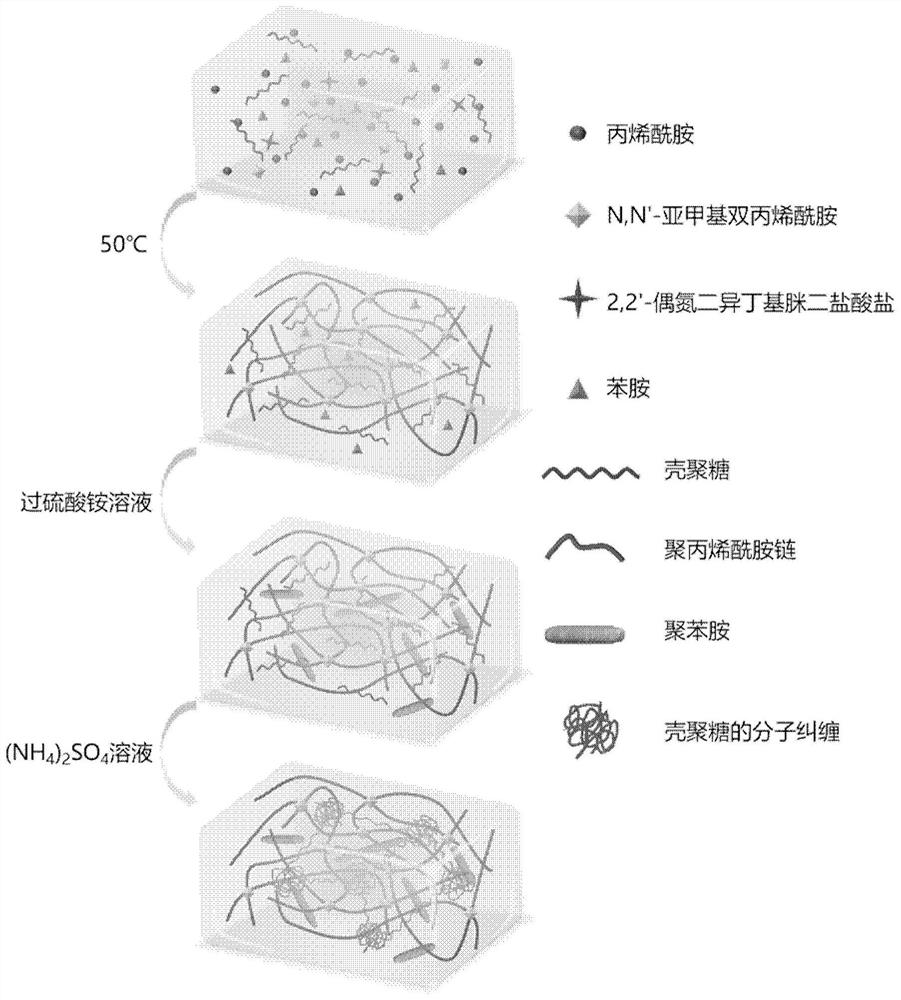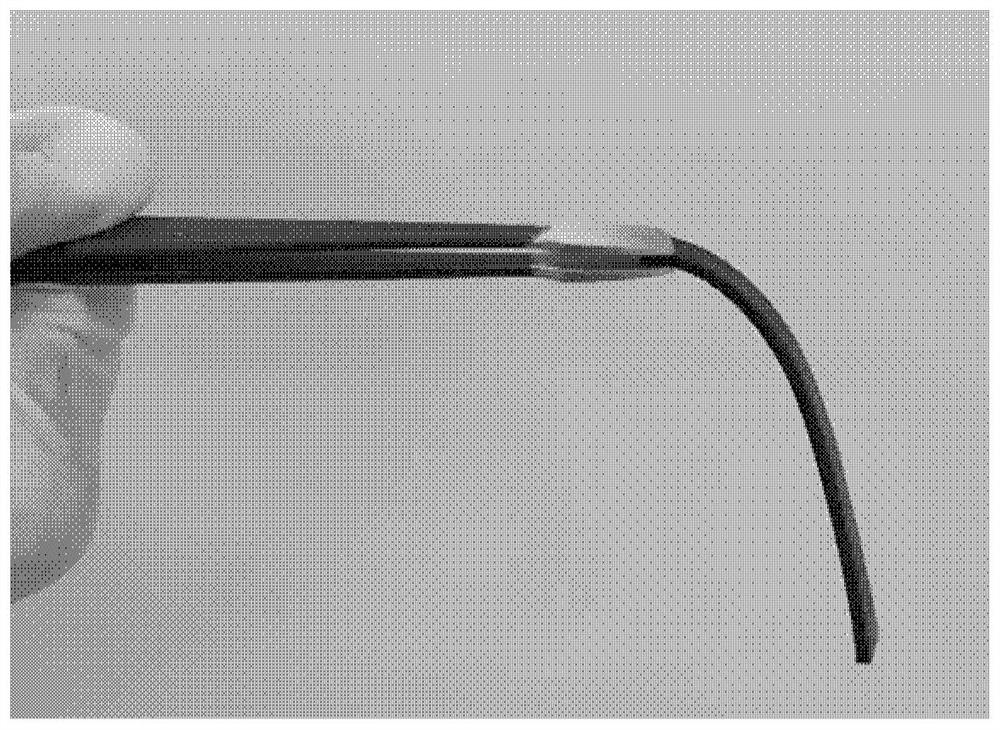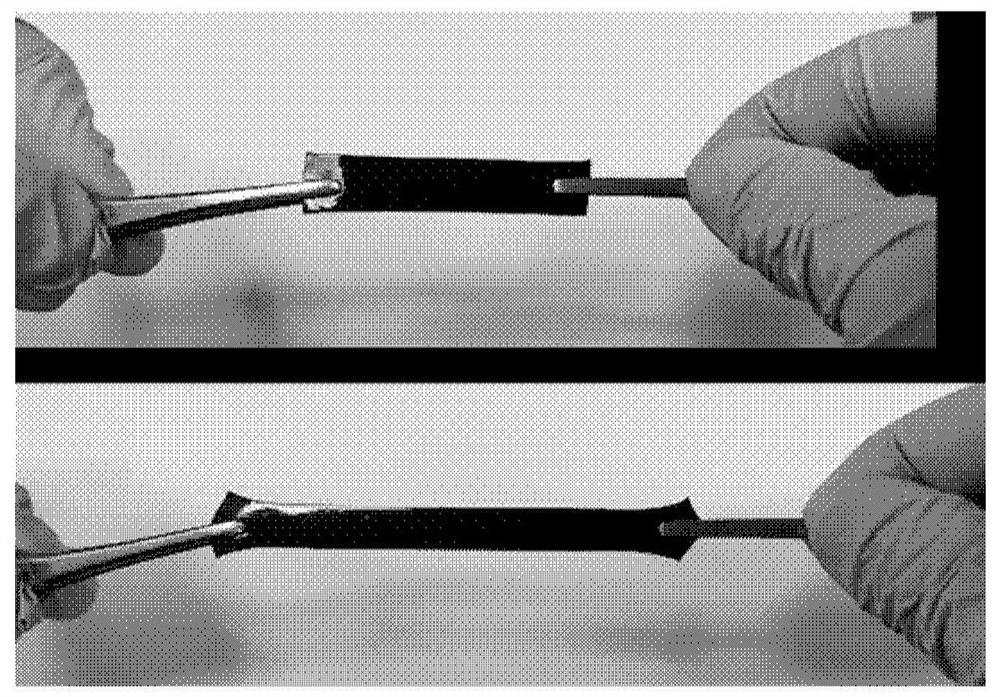Preparation method of hydrogel sensing material and hydrogel sensor
A sensing material, hydrogel technology, applied in the field of intelligent soft materials, can solve the problems of loss of elasticity and conductivity, limited use temperature, poor anti-ultraviolet performance, etc., and achieve high strength, high toughness, excellent frost resistance, ultra- The effect of strong UV resistance
- Summary
- Abstract
- Description
- Claims
- Application Information
AI Technical Summary
Problems solved by technology
Method used
Image
Examples
preparation example Construction
[0035] An aspect of the embodiments of the present disclosure provides a method for preparing a hydrogel sensing material, comprising:
[0036] Step (1) adding chitosan to hydrochloric acid to form a transparent solution under stirring in a water bath;
[0037] Step (2) After the transparent solution returns to room temperature, add acrylamide, N,N'-methylenebis(acrylamide), 2,2'-azobis(2-methylpropionamidine) dihydrochloride and aniline, and stirred to dissolve;
[0038] Step (3) Degas the stirred and dissolved solution by ultrasonic cleaning, then pour it into a mold, put the mold into a constant temperature box, use N,N'-methylenebis(acrylamide) as a crosslinking agent, 2,2'-Azobis(2-methylpropionamidine) dihydrochloride is used as a thermal initiator for free radical polymerization of acrylamide monomers in a thermostat to generate polyacrylamide composite hydrogels;
[0039] Step (4) immersing the polyacrylamide composite hydrogel in the ammonium persulfate solution, tr...
Embodiment 1
[0058] (1) Add 0.3g of chitosan to 10mL of clear water to form a transparent solution under stirring in a water bath at 55°C.
[0059] (2) After the transparent solution returns to room temperature, add 1.42g acrylamide, 10.79mg N, N'-methylenebis(acrylamide), 5.42mg 2,2'-azobis(2-methylpropionamidine) ) dihydrochloride and 250 μL aniline, and stir well to dissolve.
[0060] (3) The above solution was degassed by ultrasonic cleaning for 2 minutes, and then poured into a mold consisting of two glass plates separated by a 1 mm silicone gasket. Using N, N'-methylenebis(acrylamide) as crosslinking agent, 2,2'-azobis(2-methylpropionamidine) dihydrochloride as the thermal initiator of acrylamide monomer free The base polymerization reaction was carried out in a constant temperature box at 57°C for 12 hours to form a polyacrylamide composite hydrogel.
[0061] (4) Immerse the polyacrylamide composite hydrogel in an excess of 0.5 mol / L ammonium persulfate solution, trigger the in si...
Embodiment 2
[0064] (1) Add 0.5 g of chitosan to 10 mL of 0.5 mol / L hydrochloric acid to form a transparent solution under stirring in a water bath at 60°C.
[0065] (2) After the transparent solution returns to room temperature, add 2.13g acrylamide, 16.19mg N, N'-methylenebis(acrylamide), 8.14mg 2,2'-azobis(2-methylpropionamidine) ) dihydrochloride and 750 μL aniline, and stir well to dissolve.
[0066] (3) The above solution was degassed by ultrasonic cleaning for 5 minutes, and then poured into a mold consisting of two glass plates separated by a 2 mm silicone gasket. Free radicals of aniline monomers with N,N'-methylenebis(acrylamide) as crosslinking agent and 2,2'-azobis(2-methylpropionamidine) dihydrochloride as thermal initiator The polymerization reaction was carried out in a thermostat at 50° C. for 12 hours to generate a polyacrylamide composite hydrogel.
[0067] (4) The polyacrylamide composite hydrogel was immersed in an excess of 1 mol / L ammonium persulfate solution, and t...
PUM
 Login to View More
Login to View More Abstract
Description
Claims
Application Information
 Login to View More
Login to View More - R&D
- Intellectual Property
- Life Sciences
- Materials
- Tech Scout
- Unparalleled Data Quality
- Higher Quality Content
- 60% Fewer Hallucinations
Browse by: Latest US Patents, China's latest patents, Technical Efficacy Thesaurus, Application Domain, Technology Topic, Popular Technical Reports.
© 2025 PatSnap. All rights reserved.Legal|Privacy policy|Modern Slavery Act Transparency Statement|Sitemap|About US| Contact US: help@patsnap.com



